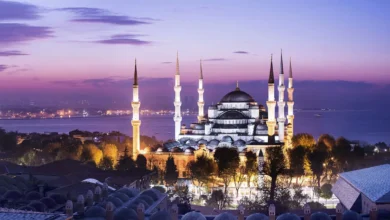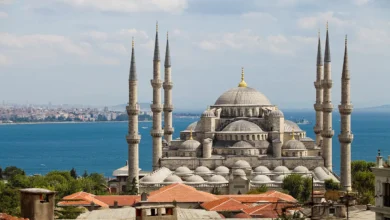
The Bosphorus Bridge, officially known as the 15 July Martyrs Bridge, stands as a remarkable symbol of Istanbul’s connection between two continents: Europe and Asia. Completed in 1973, it was the first bridge to span the Bosphorus Strait, facilitating both local and international travel between the two sides of Istanbul. This suspension bridge is not only a vital transportation link but also an iconic piece of infrastructure, with its impressive length of 1,560 meters and towering columns that rise 64 meters above the water.
Historically, the idea of a bridge across the Bosphorus has intrigued many, with early concepts dating back to Darius the Great and even Leonardo da Vinci. However, it wasn’t until the late 1960s that serious plans were made, culminating in the bridge’s construction in the early 1970s. Today, the Bosphorus Bridge remains one of the largest and most significant suspension bridges in the world, both in terms of its scale and its symbolic importance. It is also a critical part of Istanbul’s traffic infrastructure, alleviating congestion by connecting the European and Asian sides of the city.
Introduction to the Bosphorus Bridge
The Bosphorus Bridge, also known as the 15 July Martyrs Bridge, is a landmark of immense historical and symbolic significance, connecting the continents of Europe and Asia. Spanning 1.5 kilometers (approximately 1 mile) across the Bosphorus Strait, it was the first suspension bridge to bridge these two continents. Officially opened in 1973, it not only eased the flow of traffic between the European and Asian sides of Istanbul but also became a powerful symbol of Turkey’s modern infrastructure and cultural crossroads. The bridge plays a pivotal role in the daily life of Istanbul, connecting neighborhoods, businesses, and families across the Strait.

A Bridge with a History
Construction of the Bosphorus Bridge, initiated in 1970, marked the fulfillment of a long-standing vision to connect the European and Asian sides of Istanbul. Completed in 1973, the bridge was inaugurated on the 50th anniversary of the Turkish Republic, making its opening a historic milestone. The bridge features a classic suspension design, with two tall towers and massive cables holding the roadway in place, allowing for the passage of ships beneath its span. It remains an architectural marvel, symbolizing the strength of the city’s infrastructural development and its unique geographical position straddling two continents.
Traveling Across the Bridge
The Bosphorus Bridge is not only a vital transport link but also a cultural landmark that offers a unique experience for both locals and visitors. Travelers can cross it by various means, including public buses that regularly connect the European and Asian sides. For those seeking a special adventure, the annual Istanbul Eurasian Marathon offers participants the opportunity to run from Asia to Europe, giving them a memorable experience of crossing this iconic bridge on foot.

A Passage Between Two Worlds
The Bosphorus Bridge serves as a bustling passageway, carrying eight lanes of traffic daily, with cars, buses, and trucks ferrying passengers between the European and Asian sides of Istanbul. It plays a crucial role in the city’s daily life, facilitating commutes for workers, students, and those traveling for leisure. Beyond its utility, the Bosphorus Bridge holds sentimental value for locals and is a popular destination for sightseeing and leisurely strolls. From its vantage point, visitors can enjoy sweeping views of the vibrant city and the shimmering waters of the Bosphorus Strait. At night, the bridge is adorned with lights, transforming into a glowing spectacle that enhances Istanbul’s already mesmerizing skyline.
Admiring the Bridge from Below
One of the most captivating ways to admire the Bosphorus Bridge is from the waters of the Bosphorus Strait itself. Cruises along the strait offer passengers panoramic views of the bridge, providing an up-close perspective of its massive structure. These boat tours not only showcase the grandeur of the Bosphorus Bridge but also offer an opportunity to view Istanbul’s historic waterfront landmarks, such as majestic mosques and royal palaces that line the shore. The cruise experience combines scenic beauty with a touch of history, making it a must-do for anyone wanting to truly appreciate the bridge and the city from a unique angle.

Exploring Nearby Attractions
Both ends of the Bosphorus Bridge are home to noteworthy attractions that complement the bridge’s grandeur. On the European side, Ortaköy Mosque stands as a stunning example of Baroque architecture, with its delicate design and picturesque location right by the water. The surrounding Ortaköy district is a lively area, bustling with cafes, art galleries, and artisanal stalls, making it a popular spot for both locals and tourists. On the Asian side, Beylerbeyi Palace offers a glimpse into the Ottoman imperial lifestyle. Once the summer residence of sultans, the palace is set amidst lush gardens, providing an idyllic setting with sweeping views of the Bosphorus Bridge. Both locations are easily accessible and perfect for visitors looking to explore more of Istanbul’s rich history and culture.
Accessibility and Directions
The Bosphorus Bridge is conveniently located near Istanbul’s historic center, making it a short 15-minute drive from many popular tourist destinations. Public buses offer a comfortable and affordable way to reach the bridge, with frequent routes connecting the European and Asian sides. For those who prefer to enjoy the scenic surroundings on foot, the bridge can also be accessed by a leisurely stroll, providing an opportunity to take in the views of the Bosphorus and the vibrant city as you approach the landmar.

Conclusion
In conclusion, the Bosphorus Bridge offers a fascinating glimpse into Istanbul’s rich history and architectural marvels. Whether traversing the bridge by bus, participating in the annual marathon, or cruising beneath its majestic arches, visitors are sure to be captivated by the bridge’s beauty and the breathtaking views it offers.
The Bosphorus Bridge stands as a powerful symbol of Istanbul’s unique character. It embodies the city’s bridge between Europe and Asia, both geographically and culturally. The bridge’s enduring presence serves as a reminder of the importance of connection and unity, not just within Istanbul, but across the globe.
FAQs
What is the Bosphorus Bridge?
Known officially as the 15 July Martyrs Bridge, this iconic structure spans the Bosphorus Strait in Istanbul, linking Europe and Asia and symbolizing the city’s unique geography.
How long is it?
The bridge measures 1,560 meters (5,118 feet) in length, supported by towers rising 64 meters above the water.
When was it inaugurated?
It was opened on October 30, 1973, during celebrations for the 50th anniversary of the Turkish Republic.
How many lanes does it include?
It features six lanes, evenly divided for traffic in both directions.
Is there a crossing fee?
Yes, vehicles pay a toll, which varies by type.
What’s the best way to see it?
You can enjoy views from Ortaköy Square, take a boat cruise along the Bosphorus Strait, or join the Istanbul Marathon to experience crossing it on foot.
What landmarks are nearby?
Visit the picturesque Ortaköy Mosque and bustling market area on the European side. On the Asian side, explore Beylerbeyi Palace and its beautiful surroundings.
Can pedestrians walk across it?
While the bridge is generally open to vehicles only, special events like the Istanbul Marathon allow pedestrian access.





